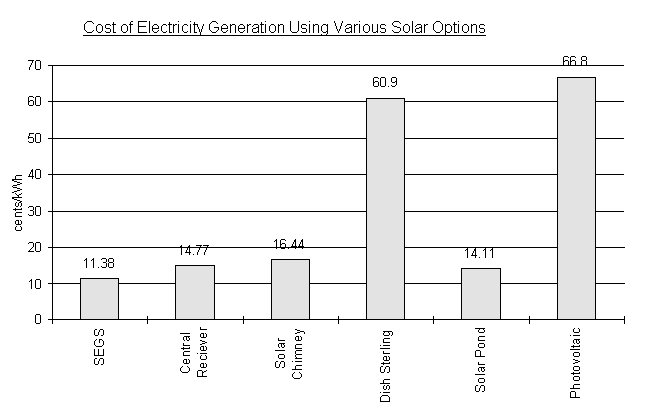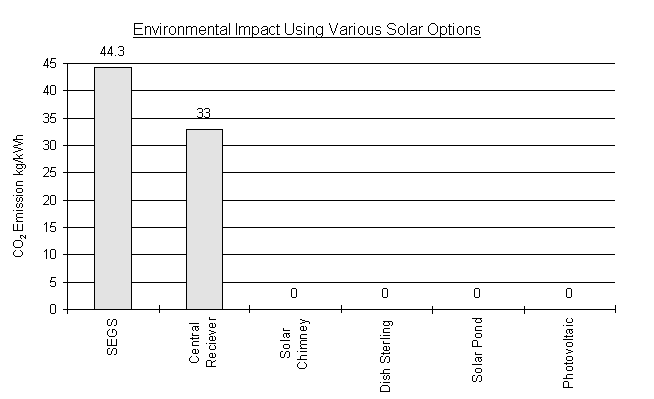

SOLAR THERMAL TECHNOLOGIES FOR POWER GENERATION
-GLOBAL SCENARIO
Solar energy provides an inexhaustible source of energy. The size of worlds solar energy resources are enormous, and the amount that can be readily accessed with existing technology significantly exceeds the worlds primary energy consumption
Solar energy, among various renewable energy sources, provides an inexhaustible source of energy. The size of worlds solar energy resources is truly enormous, and the amount that can be readily accessed with existing technology greatly exceeds the worlds primary energy consumption it has been predicted that the power plants based on solar thermal technologies in 2020 are expected to produce from 60,000 to 90,000 MW electricity per year. Solar power plants, particularly, installed in regions of high insolation is a promising option for environmentally compatible technology for electricity generation. At present, approximately 80% of the solar generated electricity is provided by power plants based on solar thermal technologies.
All solar thermal technologies are based on four basic systems: collector, receiver transport storage and power conversion. There are five major varieties of solar thermal technologies for electricity generation:
* Parabolic Trough Solar Electric Generating System (SEGS)
* Central Receiver Power Plant.
* Solar Chimney Power Plant
* Dish Sterling System
* Solar Pond Power Plant
Solar Electric Generating Systems based on parabolic trough are designed in a power range of 30-150MW. The solar receiver consists of a large array of parabolic trough reflectors that reflects the sunlight to a receiver tube located along the troughs focal line. Heat transfer fluid (HTF) flowing in the tube is heated and then pumped to a central point through a series of heat exchangers to generate superheated steam. An automatic one axis tracking system keeps the tube in the focus line during the day. Parabolic troughs operate at temperatures ranging from 100 to 4000C. The fluctuation of the solar incidence power can be compensated by a fossil fuel fired back up system that consists of a HTF-heater or boiler integrated to the steam cycle.
The HTF is pumped to a heat exchanger/evaporator for steam and power generation. Table I shows the list of selected parabolic trough solar electric generating systems.
Before 1984, more than 10 test and demonstration facilities for solar thermal process heat generation system had been erected. A number of parabolic trough suppliers are available and pursuing opportunities to build plants similar to the Luz SEGS plants at California using existing technology, with various hybridisation options including combined cycle systems. Early costs are expected to be 10-15c/kWh and technological risks are expected to be low. Because of long term successful operation of SEGS plants, World Bank/GEF funding may be available to buy down the cost of early plants in developing countries. Advanced technologies such as direct steam generation may be available within a few years which may bring down the cost still further.
|
TABLE 1. SELECTED SOLAR ELECTRIC GENERATING SYSTEMS (SEGS) |
|||
|
NAME/SITE |
POWER(MW) |
OPERATING MODE |
ON THE GRID |
|
Coolidge(USA) |
0.15 |
Solar |
1980-1982 |
|
Sunshine(Japan) |
1.0 |
Solar |
1981-1984 |
|
IEA-DCS(Spain) |
0.5 |
Solar |
1981-1985 |
|
Step-100(Australia) |
0.1 |
Solar |
1982-85 |
|
SEGS I (USA) |
14 |
Hybrid |
1985-Present |
|
SEGS II(USA) |
30 |
Hybrid |
1986-Present |
|
SEGS III-IV (USA) |
30 |
Hybrid |
1987-Present |
|
SEGS V (USA) |
30 |
Hybrid |
1988- Present |
|
SEGSVI-VII (USA) |
30 |
Hybrid |
1989- Present |
|
SEGS VIII (USA) |
80 |
Hybrid |
1990- Present |
|
SEGS IX |
80 |
Hybrid |
1991- Present |
A Central Receiver System consists of a field of heliostats, or sun tracking mirrors, which reflect solar energy to a tower mounted receiver. The concentrated heat energy absorbed by the receiver is transferred to a circulating fluid that can be stored and later used to produce power. These systems can operate at temperature 500 to 15000 C. The status of the power plant based on central receiver technology is shown in Table 2.
|
TABLE 2. STATUS OF CENTRAL RECEIVER SYSTEMS |
|||
|
NAME/SITE |
POWER(MW) |
RECEIVER COOLANT |
SERVICE PERIOD |
|
Eurelios (Italy) |
1.0 |
Water/Steam |
1980-1984 |
|
Sunshine(Japan) |
1.0 |
Water/Steam |
1981-1984 |
|
IEA-CRS(Spain) |
0.5 |
Sodium |
1981-1985 |
|
Solar one (USA) |
10.0 |
Water/Steam |
1982-1988 |
|
CESA 1 (Spain) |
1.2 |
Water/Steam |
1983-1984 |
|
Themis (France) |
2.5 |
Molten Salt |
1983-1986 |
|
MSEE(USA) |
0.75 |
Molten Salt |
1984-1985 |
|
SES-5 (USSR) |
5.0 |
Water/ Steam |
1985-1989 |
|
PHOEBUS-TSA(Spain) |
2.5 |
Air |
1992- Present |
|
Solar two (USA) |
10.0 |
Molten Salt |
Start in 1995 |
In a Solar Chimney, three well known physical principles-the flat plate air heater, the tall chimney and the vertical axis turbine-are combined in a novel way. Incident solar radiation heats the air in a large collector roof. The difference between the temperature of the air under the roof and thin ambient air causes a pressure drop over the height of the chimney. This pressure drop is converted into kinetic energy-the upwind. This kinetic energy is converted into mechanical energy by a turbine and then into electricity via a conventional generator. A solar chimney power plant can be designed for a power 30-100 MW. The first experimental plant with 50 kW electrical power was built in 1981-1982 in Manzanares,Spain. The chimney had a height of 200m, the collector covered 45,000 m2. The plant was connected to utility grid between 1986 and 1989.
In a Dish Sterling System, the solar collector (paraboloidal dish reflector) and the heat-to-electricity conversion system (Sterling engine) are mounted on one single rack. The two axis tracked device can use only direct beam radiation for electricity generation. The heat absorber of the sterling engine is placed in a focus of the dish reflector. It is cooled by gaseous hydrogen or helium. Dish sterling system are highly modular, stand alone units of 10-15KW of power that can be connected to form larger grid connected electricity plants of more than 1 MW. The characteristics of selected dish-sterling systems have been shown in Table 3..
|
TABLE 3. CHARACTERISTICS OF SELECTED DISH-STERLING SYSTEMS |
|||
|
NAME/SITE |
POWER(kW) |
WORKING GAS |
OPERATION PERIOD |
|
Vanguard (USA) |
25 |
Hydrogen |
1984-985 |
|
Mc Donnel(USA) |
25 |
Hydrogen |
1984-1988 |
|
SBP(Saudi Arabia) |
52.5 |
Hydrogen |
1984-1988 |
|
SBP(Spain, Germany) |
9 |
Helium |
1991-Present |
|
Cummins CPG(USA) |
7.5 |
Helium |
1992-Present |
|
Aisin/Miyako (Japan) |
8.5 |
Helium |
1992-Present |
|
STM-PCS(USA) |
25 |
Helium |
1993-Present |
A Solar Pond collects solar energy by absorbing both the direct and diffuse components of sunlight. Solar pond contains salt in high concentrations near the bottom, with significantly diminishing concentrations near the surface. This salt-density gradient is obtained by perfectly dissolving heavy salt with the increasing depth to suppress the natural tendency for heated fluid to rise to the surface and lose its heat to the atmosphere by evaporation, convection, and radiation. The density gradient permits heated fluid to remain in the bottom layers of the pond while the surface layers are sufficient to drive the vapour generator of an organic Rankine-cycle engine, to provide process heat and to desalt water, temperatures of 900C commonly attained in the pond bottom. The plants have been shown in Table 4.
|
TABLE 4. SELECTED SOLAR POND POWER PLANTS |
|||
| NAME/SITE | POWER(MW) | POND AREA (M2) | OPERATION PERIOD |
| Ein Boqek (Israel) | 150 | 6250 | 1979-1986 |
| Beith Ha�Arava(Israel) | 5000 | 250,000n | 1984-1989 |
| Alice Springs (Australia) | 15 | 1600 | 1985-1989 |
| El Paso (USA) | 70/330 | 3350 | 1986-Present |
A recent study has been made for the calculation of electricity generation cost and the CO2 emission using various solar thermal technologies. The different options of solar electricity generation are represented by selected reference plants that are considered typical and state-of-the art. The cost of electricity generation and environmental impact in terms of relative CO2 emissions for various solar options including photovoltaic have been shown in Figures below. The emissions of the plants are compared to an arbitrary defined present energy system, which is characterized by a typical specific CO2 emission of 1.05kg/KWh. It is clear that if a continuous development and market introduction is achieved, solar power plants will contribute substantially to the reduction of global CO2 emission. Among various solar options, most of the solar thermal technologies have better performance than photovoltaic in terms of electricity generation cost per kWh. However, the choice of the technology is quite subjective and will depend on the special circumstances at each site.


Amongst the various methods of utilising Solar Thermal Energy for power generation, only the parabolic line focusing technology (SEGS) has been proven on a commercial basis in the international arena. Only one station based on this technology has been commercially operative at Kramer Junction, California, USA. The commercial operation of this plant has been made possible due to several external factors like Government subsidies, two part tariff, hybrid operation etc. Although this plant is continuing commercial generation of electricity till date, the owner of this plant has gone bankrupt due to withdrawal of subsidy by US Government and also due to non-increase of conventional fuel costs. Latest reports dated July,1997 indicate that this station has set new records in the field of commercial solar power generation. Recent project development and feasibility assessments for large installations in Greece, India & Morocco and other countries of the sun-belt indicate that investment costs will decrease for the next installations by 15 to 20% compared to the existing latest SEGS facilities. With integration into combined steam cycles investment costs upto 900 US$ per kW have been worked out. Related power generation costs for a 175MWe Integrated Solar Combined Cycle plant are about 4 UScents/kWh.
-INDIAN SCENARIO
In India one Solar Thermal Power Plant of 50kW capacity has been installed by MNES following the parabolic trough line focussing technology at Gwalpahari, Gurgaon. This plant was commissioned in April,1989 and operated till October,1990, after which the plant was shut down due to lack of spares. Revival work was undertaken in September,1995 and the plant was recommissioned in February,1996. Several spares have been fabricated indigenously and the plant is still under operation. However due to damage to some critical parts like reflector mirrors & glass vacuum tubes, the capacity of this plant has reduced considerably. These critical parts are still not manufactured in the country and original German supplier of the plant equipment(MAN) has already shutdown this business six years ago. Efforts are still on to replace or repair damaged components indigenously.
A Solar Thermal Power Plant of 140MW has been proposed and sanctioned by the Government in Rajasthan. The project configuration of 140MW Integrated Solar Combined Cycle Power Plant involves a 35MW solar power generating system and a 105MW conventional power component. The GEF has approved a grant of US$ 40 million for the project. The Government of Germany has agreed to provide a soft loan of DM 116.8 million and a commercial loan of DM 133.2 million for the project.
Another Solar Energy based commercial power plant based on Solar Chimney technology is being planned in North-Western part of Rajasthan. The project is to be implemented in five stages. In the 1st stage the power output shall be 1.75MW which shall be enhanced to 35MW, 70MW, 126.3MW and 200MW in subsequent stages. The height of the solar chimney which would initially be 300m shall be increased gradually to 1000m. Cost of electricity through this plant is expected to be Rs. 2.25 / kWh.
The following issues need to be addressed before deciding on the technology to be adopted :
In the parabolic point Focussing Dish Technology, some demonstration plants have been built in several parts of the world, especially in Australia. However, the capacity of such plants is very small being around 50kW in Australia. Although, considerable theoretical information is available in this technology, there has not been much success in this route primarily because centralized generation of power in this route does not seem possible due to technical reasons. Also development of Sterling Engine is an essential requirement for this route and present indications are that we have a long way to go for commercialisation of this technology. Further, the physical size of a dish restricts the power to be generated in this system. One Solar Thermal Power Plant following the Dish-technology and owned by Ministry of Non-Conventional Energy Sources has been built by BHEL in India under the supervision of U.S. Agencies and MNES. Six dishes used in this plant have been designed for centralized generation of power. It is understood that BHEL has gained very useful knowledge is setting up of this plant and in their opinion, the system followed in this plant can not be considered for centralized generation of power. The plant is not in operating condition and is likely to be disposed off. A look at this plant would reveal that there are too many practical problems in this dish technology for effecting generation of power in a centralized manner.
Sources :

BACK TO MY HOME PAGE | IGCC | CFBC | PFBC | SOLAR THERMAL | WIND POWER | GEOTHERMAL | FUEL CELLS | COALBED METHANE